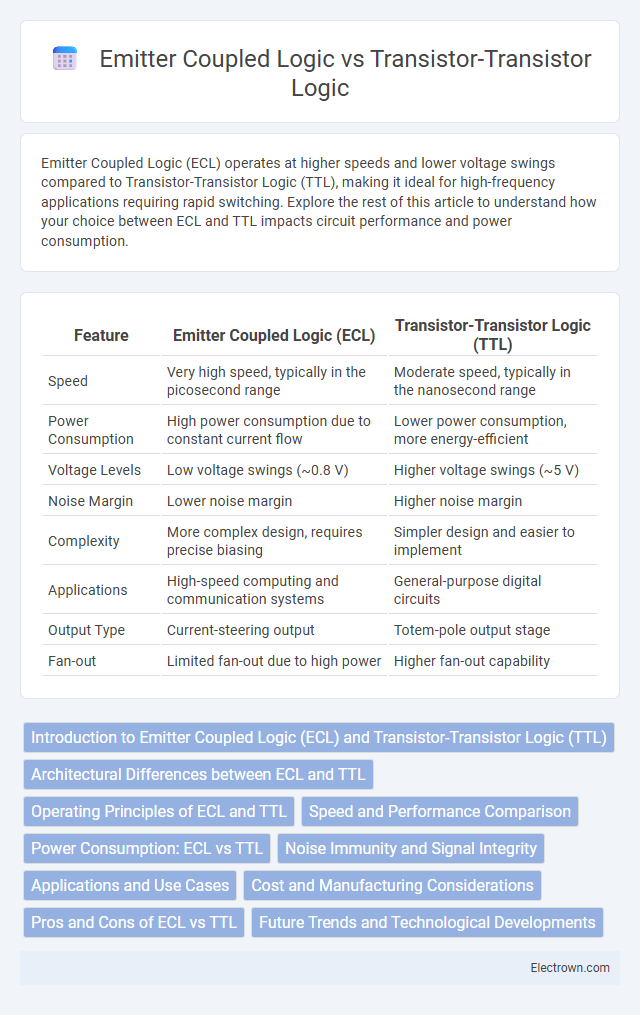Emitter Coupled Logic (ECL) operates at higher speeds and lower voltage swings compared to Transistor-Transistor Logic (TTL), making it ideal for high-frequency applications requiring rapid switching. Explore the rest of this article to understand how your choice between ECL and TTL impacts circuit performance and power consumption.
Table of Comparison
| Feature | Emitter Coupled Logic (ECL) | Transistor-Transistor Logic (TTL) |
|---|---|---|
| Speed | Very high speed, typically in the picosecond range | Moderate speed, typically in the nanosecond range |
| Power Consumption | High power consumption due to constant current flow | Lower power consumption, more energy-efficient |
| Voltage Levels | Low voltage swings (~0.8 V) | Higher voltage swings (~5 V) |
| Noise Margin | Lower noise margin | Higher noise margin |
| Complexity | More complex design, requires precise biasing | Simpler design and easier to implement |
| Applications | High-speed computing and communication systems | General-purpose digital circuits |
| Output Type | Current-steering output | Totem-pole output stage |
| Fan-out | Limited fan-out due to high power | Higher fan-out capability |
Introduction to Emitter Coupled Logic (ECL) and Transistor-Transistor Logic (TTL)
Emitter Coupled Logic (ECL) is a high-speed digital circuit design that uses differential amplifier configurations to achieve faster switching times compared to other logics. Transistor-Transistor Logic (TTL) relies on bipolar junction transistors for digital signal processing, known for moderate speed and ease of integration. Your choice between ECL and TTL impacts circuit speed, power consumption, and noise margins in digital electronics design.
Architectural Differences between ECL and TTL
Emitter Coupled Logic (ECL) uses differential amplifier configurations with transistors operating in the active region for high-speed switching, while Transistor-Transistor Logic (TTL) employs multi-emitter transistors with saturated transistors switching between cutoff and saturation states. ECL's architecture avoids transistor saturation, minimizing propagation delay and offering faster switching speeds compared to TTL's saturation-based design. The voltage levels in ECL are shifted to smaller swings for faster transitions, whereas TTL uses larger voltage swings and relies on transistor saturation for noise immunity.
Operating Principles of ECL and TTL
Emitter Coupled Logic (ECL) operates by steering current through differential transistor pairs, ensuring rapid switching with minimal voltage swing, which significantly boosts speed and reduces propagation delay. Transistor-Transistor Logic (TTL) relies on bipolar junction transistors switching between cutoff and saturation states, resulting in slower transitions due to larger voltage swings and transistor switching times. Understanding these operating principles helps you select the appropriate logic family based on speed requirements and power consumption constraints in digital circuit design.
Speed and Performance Comparison
Emitter Coupled Logic (ECL) offers significantly higher speed and performance compared to Transistor-Transistor Logic (TTL), with switching times typically in the picosecond range versus nanoseconds for TTL. ECL achieves faster operation due to its differential amplifier design, which minimizes transistor saturation and allows rapid signal transitions. TTL, while slower, provides lower power consumption and is easier to interface, making ECL preferable for ultra-high-speed applications such as microwave and high-frequency digital circuits.
Power Consumption: ECL vs TTL
Emitter Coupled Logic (ECL) typically exhibits higher power consumption compared to Transistor-Transistor Logic (TTL) due to its constant current operation, which results in continuous power dissipation regardless of switching activity. TTL circuits consume power primarily during state transitions, making them more energy-efficient in low-frequency applications. However, ECL's faster switching speeds come at the cost of increased power usage, making power consumption a critical consideration in high-speed digital circuit design.
Noise Immunity and Signal Integrity
Emitter Coupled Logic (ECL) offers superior noise immunity and signal integrity compared to Transistor-Transistor Logic (TTL) due to its differential amplifier structure and constant current operation, which minimizes voltage swings and reduces susceptibility to noise. ECL's faster switching speeds also contribute to lower signal distortion and improved timing accuracy, maintaining signal integrity in high-frequency applications. TTL circuits, while robust and cost-effective, exhibit higher voltage swings and slower transitions that can degrade noise margins and signal clarity in demanding environments.
Applications and Use Cases
Emitter Coupled Logic (ECL) excels in high-speed applications such as telecommunications, radar systems, and high-frequency computing due to its rapid switching capabilities and low propagation delay. Transistor-Transistor Logic (TTL) is widely used in digital circuits like microprocessors, control systems, and standard logic operations where moderate speed and cost efficiency are critical. ECL's higher power consumption limits its use to specialized environments, whereas TTL remains dominant in general-purpose electronics and embedded systems.
Cost and Manufacturing Considerations
Emitter Coupled Logic (ECL) circuits typically incur higher manufacturing costs compared to Transistor-Transistor Logic (TTL) due to their complexity and higher power consumption requirements. TTL's simpler design and widespread adoption result in more cost-effective mass production, making it a preferred choice for budget-sensitive applications. Your decision between ECL and TTL should weigh performance needs against manufacturing expenses to optimize both cost and efficiency.
Pros and Cons of ECL vs TTL
Emitter Coupled Logic (ECL) offers significantly faster switching speeds compared to Transistor-Transistor Logic (TTL), making it ideal for high-frequency applications like RF and microwave circuits, but it consumes higher power and generates more heat. TTL provides lower power consumption and simpler circuit design, which enhances cost-effectiveness and ease of integration, yet it suffers from slower switching speeds and limited operating frequency. ECL's noise margins are generally lower than TTL, requiring careful design considerations to maintain signal integrity in complex digital systems.
Future Trends and Technological Developments
Emitter Coupled Logic (ECL) technology, known for its high speed and low voltage swing, faces increasing integration challenges with modern semiconductor processes favoring low power and high-density designs typical of Transistor-Transistor Logic (TTL) derivatives. Future trends highlight a shift toward complementary metal-oxide-semiconductor (CMOS) logic due to its superior energy efficiency and scalability, impacting the development and application of traditional ECL and TTL circuits. Advancements in silicon photonics and quantum computing are expected to further diminish the reliance on conventional ECL and TTL technologies by providing faster, more power-efficient alternatives.
Emitter Coupled Logic vs Transistor-Transistor Logic Infographic

 electrown.com
electrown.com